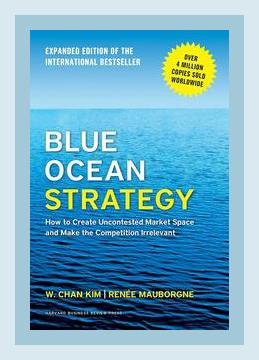Business StrategyBlue Ocean Strategy
Creating Blue Oceans: A Guide on How to Pursue New Market Space and Make the Competition Irrelevant by Al Diaz (2016) – Summary
Introduction: Understanding Blue Ocean Strategy
The book “Creating Blue Oceans” by Al Diaz elucidates the Blue Ocean Strategy, a business theory that suggests companies are better off searching for ways to gain “uncontested market space” than competing with similar companies. It gives a strategic approach for breaking away from the intense rivalry in existing, saturated markets, or “red oceans,” and distinguishes itself by venturing into “blue oceans,” where new growth opportunities abound. This summary distills key points and actions from the book, structured to provide a comprehensive guide.
1. Understanding Current Market Conditions
Major Point: The book starts by highlighting the trap of competing within existing market boundaries, which often leads to a zero-sum game.
Example: Diaz discusses the case of the automotive industry where firms battle within the same parameters like luxury features, fuel efficiency, and brand loyalty.
Action Step:
– Conduct a Market Analysis: A company should thoroughly analyze its current market conditions to identify over-saturated areas. This entails evaluating competitor strategies, customer pain points, and market trends.
2. Reconstructing Market Boundaries
Major Point: Diaz lays out strategies to break away from the competitive environment by redefining market boundaries.
Example: The book quotes the example of Cirque du Soleil, which transcended traditional circus performances and theater, creating an entirely new form of entertainment.
Action Step:
– Explore Complementary Products or Services: Businesses should look at complementary products or industries for inspirations. They can combine elements from different sectors to offer unique value propositions.
3. Focus on the Big Picture, Not the Numbers
Major Point: Diaz stresses the importance of looking at the big picture rather than getting bogged down by quantitative analysis and incremental improvements.
Example: When Nintendo introduced the Wii, it didn’t try to compete on graphics and processing power (traditional video game metrics). Instead, it focused on intuitive, motion-sensing gameplay that appealed to a broader audience.
Action Step:
– Develop a Clear Vision of Market Space: Define a vision for where your business can create a “blue ocean.” Create strategic canvases to visualize current market position and potential new spaces.
4. Reach Beyond Existing Demand
Major Point: Expanding beyond existing customers and tapping into noncustomers can open up new avenues for growth.
Example: Diaz refers to Southwest Airlines, which targeted price-sensitive travelers who previously would have considered bus travel over air travel.
Action Step:
– Identify Noncustomers: Segment potential customers into “soon-to-be” noncustomers (on the edge of your market), “refusing” noncustomers (choosing against your market), and “unexplored” noncustomers (beyond current market boundaries), and strategize on how to convert them.
5. Develop a Unique Value Proposition
Major Point: For a blue ocean strategy to succeed, it must offer differentiation paired with low cost.
Example: Apple’s iTunes transformed the music industry by providing a convenient, legitimate way to purchase individual songs, undercutting illegal downloads.
Action Step:
– Map Out Value Innovation: Identify elements of differentiation that can be paired with the cost savings to create a disruptive market proposition. Engage in brainstorming sessions with a cross-functional team to generate innovative ideas.
6. Overcome Organizational Hurdles
Major Point: Implementing a blue ocean strategy requires overcoming four key hurdles: cognitive, limited resources, motivation, and politics.
Example: Pfizer faced organizational resistance when launching its cholesterol drugs. To break through, it appointed influential leaders who could sway opinion and mobilize change across departments.
Action Step:
– Build a Change Coalition: Form a team of influential leaders within the organization who can drive change, allocate resources effectively, and maintain momentum by communicating success stories and quick wins.
7. Implement and Execute a Blue Ocean Strategy
Major Point: Execution is where many strategic transformations fail. Diaz states clear implementation steps are vital.
Example: Zara disrupted the fashion industry by creating a fast fashion model, which required overhauling its entire supply chain and inventory management systems to implement effectively.
Action Step:
– Develop an Implementation Plan: Lay out a step-by-step execution plan including timelines, responsibilities, and benchmarks for measuring success. Regularly revisit and adapt the plan based on feedback and evolving market conditions.
8. Sustainability and Continuous Innovation
Major Point: To maintain a blue ocean, companies need to continuously innovate and adapt to changing market realities.
Example: Tesla, after creating a blue ocean with electric vehicles, continues to innovate with self-driving technology and energy solutions to stay ahead.
Action Step:
– Invest in R&D: Allocate a significant portion of resources to research and development. Encourage a culture of innovation among employees, allowing them to experiment and share ideas without fear of failure.
Conclusion: A Permanent Shift in Strategic Perspective
In “Creating Blue Oceans,” Al Diaz emphasizes that pursuing new market space and making competition irrelevant is not a one-time effort but a continuous process. The book provides actionable insights into rethinking competitive strategy by focusing on value innovation, exploring untapped markets, and ensuring sustainable growth through constant innovation. Diaz’s concrete examples and strategic frameworks help translate the theory of Blue Ocean Strategy into practical steps that any business can follow to create lasting market divergence.
